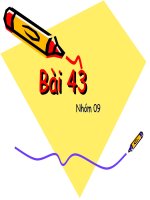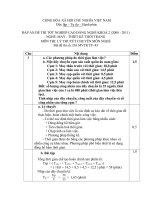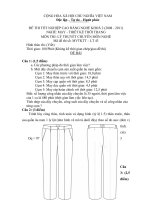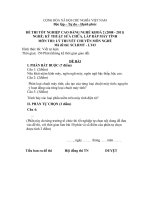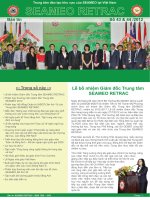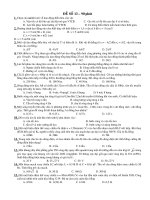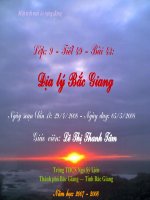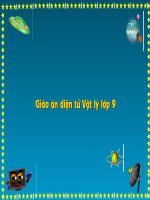PASSAGE 43
Bạn đang xem bản rút gọn của tài liệu. Xem và tải ngay bản đầy đủ của tài liệu tại đây (43.63 KB, 2 trang )
PASSAGE 43
Archaeologists from Vietnam and Japan have unearthed valuable artifacts inside the citadel of the Ho
Dynasty (1400 – 1407) in central province of Thanh Hoa. The excavated area, covering 46.5sqm of the
highest point inside the citadel, made up the main part of the royal palace, comprising Nhan Tho Palace –
the king’s residence – and Hoang Nguyen Court Hall, according to historic files. From August 19 to 29,
the archaeologists found four stone pillars in the design style of the Ly – Tran dynasties and two
overlapping brick foundations, which they believe were once part of one building in the royal palace. One
the east side, they found a lotus – decorated stone base measuring 68 x 68 x 40cm, which suggests the
presence of an extraordinary large base. Other findings included two stone bars measuring 1 m long and a
brick sewer. The Ho Dynasty reigned for a short period but left an important mark on Vietnam’s history.
The Ho Citadel was built in 1402 in Vinh Loc District according to the Dai Viet Su Ky Toan Thu
(Complete History of Dai Viet).
Question 1. What does “unearthed” in the passage mean?
A. figured out
B. put up
C. found out
D. dug up
Question 2. The Ho Dynasty, according to the passage, lasted for _________.
A. 7 years
B. 19 years
C. 2 years
D. 29 years
Question 3. The findings don’t include _________.
A. stone bars
B. a lotus – decorated stone base
C. historic files
D. a brick sewer
Question 4. Where can this passage be found? In a(n) _________.
A. tourist brochure
B. newspaper article
C. advertisement
D. leaflet
Question 5. The following can’t be inferred from the passage EXCEPT _________.
A. the Ho Citadel was built as a king’s residence on the east side of Thanh Hoa
B. four stone pillars of the Ly – Tran dynasties were found inside the citadel
C. the Ho Dynasty was of a short period in Vietnam’s history
D. Vietnamese archaeologists helped the Japanese to fulfill their historic project
ĐÁP ÁN
1-D
2-A
3-C
4-B
5-C
LỜI GIẢI CHI TIẾT
Question 1:
Question 2:
Question 3:
The findings includes: [“a lotus – decorated stone base…”]; [“…stone bars measuring 1 m long and a
brick sewer.”]
Question 4:
Question 5:
[“The Ho Dynasty reigned for a short period but left an important mark on Vietnam’s history.”]
• Bài dịch tham khảo:
Các nhà khảo cổ học đến từ Việt Nam và Nhật Bản đã khai quật ra các hiện vật quý giá bên trong thành trì
triều đại nhà Hồ (1400-1407) ở tỉnh Thanh Hoá. Khu di tích được khai quật, chiếm 46,5m2 điểm cao nhất
bên trong thành, là bộ phận chính của cung điện hồng gia, bao gồm Cung điện Nhân Thọ - nơi vua ở và
điện Hoàng Nguyên nơi thiết triều, theo như các ghi chép lịch sử. Từ ngày 19 đến 29 tháng 8, các nhà
khảo cổ học đã tìm thấy bốn trụ đá theo phong cách thiết kế của triều đại Lý Trần và hai nền gạch được
lát chồng lên nhau, mà họ cho rằng đã từng là một bộ phận của một tịa nhà trong cung điện hồng gia. Ở
vách phía đơng, họ tìm thấy một khối đá được trang trí họa tiết hoa sen kích thước 68 x 68 x 40cm, cho
thấy sự hiện diện của một căn cứ lớn khác thường. Các phát hiện khác bao gồm hai thanh đá dài 1 mét và
một ống cống bằng gạch. Triều đại nhà Hồ trị vì trong một thời gian ngắn nhưng đã để lại dấu ấn quan
trọng cho lịch sử Việt Nam. Thành nhà Hồ được xây dựng năm 1402 tại huyện Vĩnh Lộc theo Đại Việt Sử
Ký Toàn Thư.
